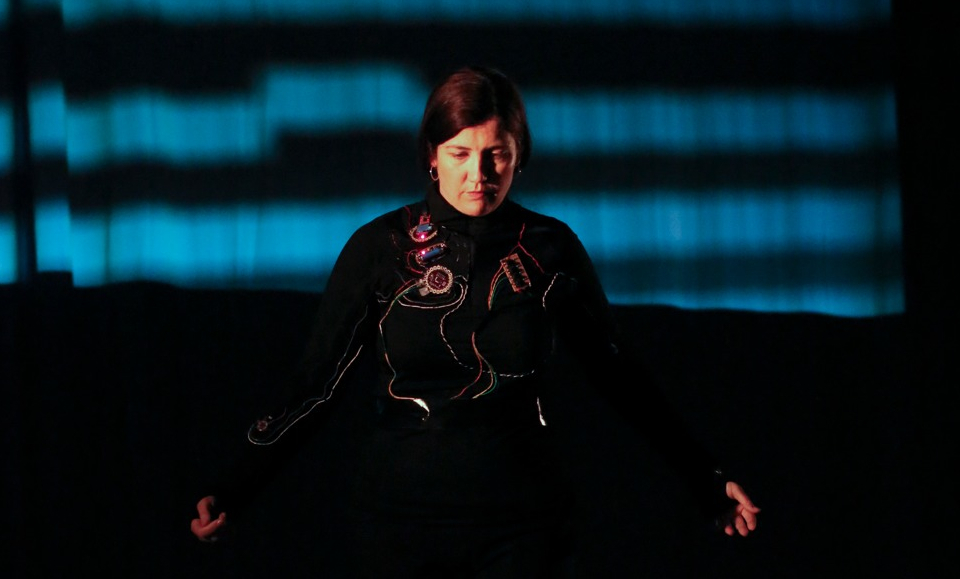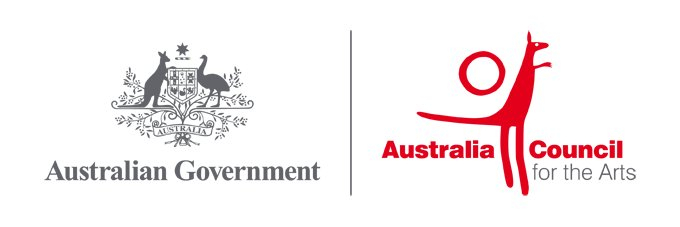 Legs On The Wall – Open Source artist residency
Legs On The Wall – Open Source artist residency
In Nov/Dec 2012, Macrophonics were selected as artists in residence for the Legs On The Wall R&D program Open Source. This project was supported by the Australia Council for the Arts and provided an opportunity for artists working with media technologies to undertake a month long residency with the company to research and develop an aspect of digital media in theatre/performance contexts. Julian Knowles, Donna Hewitt and Tim Bruniges spent a month in residence in the Red Box facility in Lilyfield, Sydney, culminating in a proof-of-concept showing in Dec 2012 of some new interfacing approaches and a new prototype wearable performance interface. The residency provided an opportunity to build on the work and momentum of the initial Macrophonics Brisbane Festival project in 2011.

Here’s a video showing the first test run of the interface. In this example the movements of the performer are driving and processing audio materials.
Here’s a documentation video of our work in progress showing at the Red Box.
A photo gallery of the showing is available here.
If you are technically minded, you can read a detailed account of our R&D process in the project blog entries
The interface development has been ongoing and a new wireless version of the interface was developed and tested and debuted in the new work Ghost Ships.
Background
Much of our work to date has been focused on sensing in an ‘instrumental music’ fashion, drawing upon music models for performer/technological interaction. In this project we set out to examine the ways in which we could move beyond these models and work with live theatre performers as agents within a multi-performer sensing project.
Space and body sensing strategies were explored to create a ‘performer-centred’ responsive environment. This concept drew upon instrumental models from musical interfacing (where a performer is in control of musical elements) and carries the idea into a theatrical context, where the performers become the agents for media control, rather than the technical crew.
The overall objective was to augment the expressive range of the theatre performer by situating them in a highly responsive environment – specifically to explore and define new direct relationships between the theatre performers, musicians and media artists who traditionally work with a network of indirect or interpretive relationships with one another.
The second area of investigation was to examine in what ways a media performance ensemble might be integrated into the on-stage context, such that the line between theatre performer and composer/performer/media artist is blurred. This echoes some of the pioneering work of The Wooster Group in the early 1990s in which the line between live action and recorded action was blurred in parallel with the line between performer and ‘technician’. We were lucky enough to see The Wooster Group’s performance of Chekov’s Three Sisters, called ‘BraceUp!’, at the Performing Garage in New York, directed by Elizabeth LeCompte. In bringing these media rich works to fruition, the ‘technical’ or ‘off stage’ creative team were treated as part of the performance ensemble in the development process. The media set-up (in the early 1990s it was TVs, videotape recorders, cameras, microphones etc.) was established at the beginning of the rehearsal process and informed all aspects of the dramaturgical rendering of the work (Mee, 1992).
The major experiment was to see an ensemble of media artists brought into a set of direct performer to performer relationships through performance data exchange and to devise working methods and processes which might open up new dramaturgical potentials.


